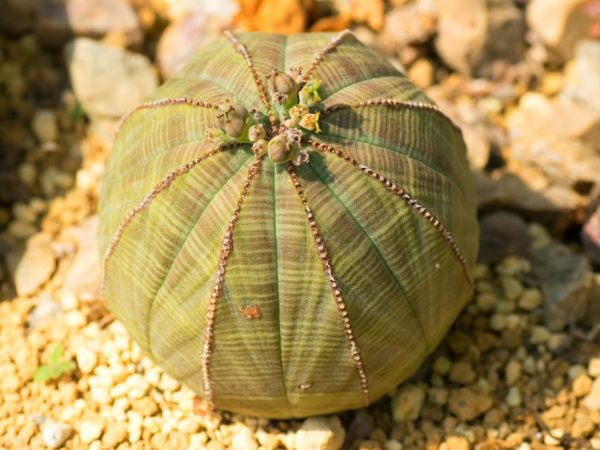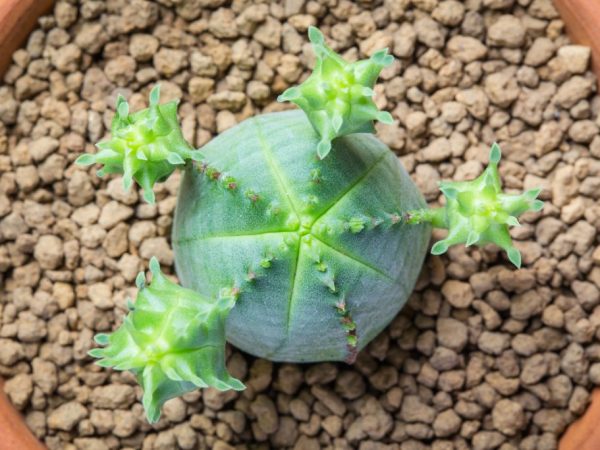Decorative spurge Fat
Euphorbia obesa is an original euphorbia native to South Africa. It grows in the Kendreu area on stony-shale soils. It has a decorative appearance, resembling a slightly ribbed ball. Other names for it - "plump" or "fat", the Americans called the succulent "baseball plant".

Decorative spurge Fat
Description
Fat euphorbia is a perennial succulent that can be grown indoors or in the garden (in a suitable climate). With a spherical or slightly elongated shape of a lush trunk, it resembles a ball. The plant reaches a height of 15-30 cm, in diameter - up to 10 cm. An adult specimen has no branches, thorns and leaves. Rarely enough, miniature flowers with a delicate pleasant aroma appear on it.
This succulent is not just round or oblong - it has a slight vertical ribbing, which only enhances its decorative effect. Usually there are 8 such ribs. The color of the "ball" is green, brownish, grayish or steel. Sometimes beautiful transverse stripes of red-lilac shades are formed on it. This species is bisexual (some plants have female flowers, while others have male flowers).
Milkweed juice, which stands out when broken or cut, is poisonous. It causes burns to the mucous membranes and irritation to the skin.
Purchase and adaptation
This type is rare and is not sold in every specialized store. In addition, seeds are offered much more often than an already grown specimen. However, a finished plant can also be found. Usually they ask for it from 600 to 1500 rubles. When buying, you should make sure that the "miracle ball" is healthy: it should not have any extraneous stains or any damage.
Adaptation
- For the first two to three weeks, do not transplant euphorbia and, for the sake of caution, keep it away from other flowers.
- Watch the plant for disease or signs of insect pests.
- Create a comfortable environment for the succulent. He should be warm and light, like in his homeland.
Home care

Unpretentious flower
Obese spurge is completely unpretentious. It takes very little effort to grow a healthy and beautiful succulent. The main care measures are to create comfortable conditions, proper watering and moderate feeding.
Priming
Milkweed is suitable for obese universal soil or soil mixture for succulents. A little coarse sand should be added to the ground. The main requirement for the soil is a slightly acidic reaction.
Lighting
The plant loves light, but can grow in light shade. The best option would be a sunny location on the south side of the house, but not in direct sunlight. You should adhere to the pattern: the more sun - the more often watering and vice versa.
Watering and humidity
In the warm season, watering is carried out every two weeks. Before the next procedure, the soil should be completely dry. Water more frequently during hot sunny periods. In winter - once a month. Euphorbia is not picky about air humidity.
Temperature
This species is an African inhabitant, therefore it is thermophilic. The ideal summer temperature is 25 ° C (possibly up to 30 ° C). The plant adequately withstands temporary drought and cold snaps (down to -10 ° C).
Fertilizers
This species needs moderate feeding. It can be fed once a season - during breeding. It is better to use ready-made complexes for succulents. Fertilizers with a high nitrogen content are not recommended.
Transfer
As it grows, euphorbia is transplanted into a more spacious container (or, if necessary, plant young succulents grown from seeds in one box). You need to work with gloves, since the plant sap is poisonous. Choose a pot that is not too deep, but be sure to have holes. A drainage layer can be laid on the bottom. The flower is moved with an earthen lump, watered, sprinkled with a substrate, and small pebbles are placed on top to create support for growth.
Reproduction
You can propagate fatty euphorbia in only one way - by seeds. For self-collecting seeds, you need to have a pair of plants - male and female, and during flowering - transfer pollen from one to another. When seed pods appear, the succulent is covered with a thick net so that the seeds are not scattered. After 10 days, they will ripen for sowing.
It is much easier to buy ready-made material. In any case, the seeds must first be soaked, and then sown into a moistened substrate from soil and sand. The container is covered with plastic wrap for two weeks until sprouts appear. After germination, it is advisable to lay out small pebbles on the surface of the soil in order to avoid overheating of the earth and increase the resistance of young succulents. After 3-4 months, they can be transplanted into separate pots.
Diseases and pests
| Problem | Signs | Prophylaxis | Treatment |
| Whitefly | White insects with wings, the appearance of a sooty fungus. | Moderate humidity, regular ventilation of the room. | Washing with a solution of laundry soap; Spraying with garlic infusion; Hanging sticky tapes to catch insects; In serious cases, treatment with biological products or insecticides (Actellik, Fufanon, Pegasus). |
| Mealybug | The surface is sticky, yellowish spots appear, a waxy white bloom. | Regular inspection and washing of plants. | Cleansing with a brush and soapy water; Treatment with alcoholic infusion of calendula; In case of severe damage, the use of drugs: Aktara, Confidor, Fitoverm. |
| Mold | White spots of a fluffy texture. | Adhere to the correct irrigation regime, avoid excessive moisture. | Remove mold from the plant and the surface of the soil, if necessary, transplant the flower, cut off the affected leaves. Let the soil dry and add an antifungal agent to it. Treat the succulent with a fungicide (Actellik, Decis). |

